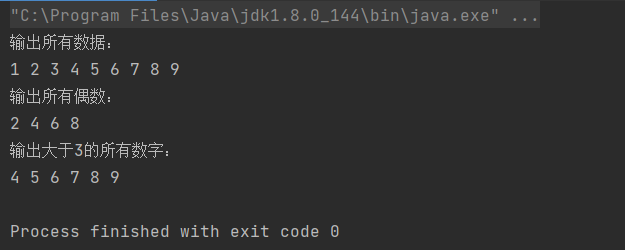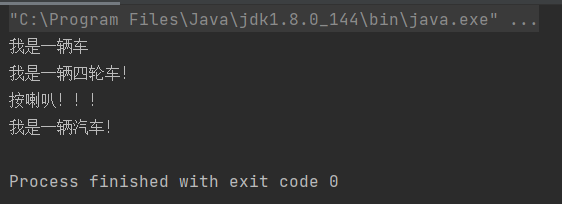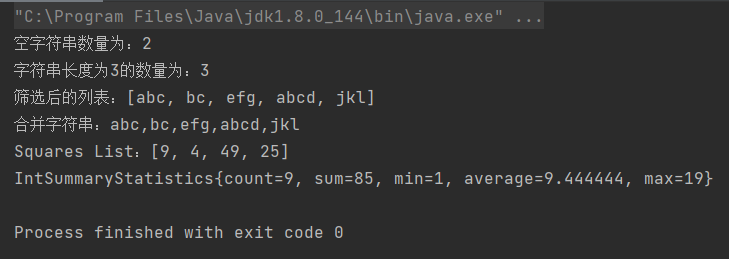1 Lambda表达式 Lambda 允许把函数作为一个方法的参数(函数作为参数传递进方法中)。
以下是lambda表达式的重要特征:
可选类型声明: 不需要声明参数类型,编译器可以统一识别参数值。可选的参数圆括号: 一个参数无需定义圆括号,但多个参数需要定义圆括号。可选的大括号: 如果主体包含了一个语句,就不需要使用大括号。可选的返回关键字: 如果主体只有一个表达式返回值则编译器会自动返回值,大括号需要指定表达式返回了一个数值。
1 2 3 4 5 6 7 8 9 10 11 12 13 14 15 16 17 18 19 20 21 22 23 24 25 26 27 28 29 30 31 32 33 34 35 36 37 38 39 40 41 42 43 package jdk8;public class LambdaTest public static void main (String[] args) new LambdaTest();int a, int b) -> a + b;"10 + 5 = " + test.operate(10 , 5 , addition));"10 - 5 = " + test.operate(10 , 5 , subtraction));int a, int b) -> { return a * b; };"10 * 5 = " + test.operate(10 , 5 , multiplication));int a, int b) -> a / b;"10 / 5 = " + test.operate(10 , 5 , division));"hello " + message);"hello " + message);"world" );"world" );interface GreetingService void sayMessage (String message) interface MathOperation int operation (int a, int b) private int operate (int a, int b, MathOperation mathOperation) return mathOperation.operation(a, b);
运行结果
2 方法引用 方法引用通过方法的名字来指向一个方法。
1 2 3 4 5 6 7 8 9 10 11 12 13 14 15 16 17 18 19 20 21 22 23 24 25 26 27 28 29 30 31 32 33 34 35 36 37 38 39 40 41 42 43 package jdk8;import java.util.Arrays;import java.util.List;import java.util.function.Supplier;public class MethodTest public static void main (String[] args) final Car car = Car.create( Car::new );final List<Car> cars = Arrays.asList(car);final Car police = Car.create(Car::new );class Car public Car () "hello car" );public static Car create (final Supplier<Car> supplier) return supplier.get();public static void collide (final Car car) "Collied " + car.toString());public void follow (final Car another) "Following the " + another.toString());public void repair () "Repaired " + this .toString());
运行结果
3 函数式接口 函数式接口(Functional Interface)就是一个有且仅有一个抽象方法,但是可以有多个非抽象方法的接口。
1 2 3 4 5 6 7 8 9 10 11 12 13 14 15 16 17 18 19 20 21 22 23 24 25 26 27 28 29 30 31 32 33 34 35 36 37 38 39 package jdk8;import javax.xml.transform.Source;import java.util.Arrays;import java.util.List;import java.util.function.Predicate;public class FunctionInterfaceTest public static void main (String[] args) 1 , 2 , 3 , 4 , 5 , 6 , 7 , 8 , 9 );"输出所有数据:" );true );"输出所有偶数:" );2 == 0 );"输出大于3的所有数字:" );3 );public static void eval (List<Integer> list, Predicate<Integer> predicate) for (Integer n : list) {if (predicate.test(n)) {" " );"" );
运行结果
4 默认方法 默认方法就是接口可以有实现方法,而且不需要实现类去实现其方法。
1 2 3 4 5 6 7 8 9 10 11 12 13 14 15 16 17 18 19 20 21 22 23 24 25 26 27 28 29 30 31 32 33 34 35 package jdk8;public class DefaultMethod public static void main (String[] args) new Car();interface Vehicle default void print () "我是一辆车" );static void blowHorn () "按喇叭!!!" );interface FourWheeler default void print () "我是一辆四轮车!" );static class Car implements Vehicle , FourWheeler @Override public void print () super .print();super .print();"我是一辆汽车!" );
运行结果
5 Stream Stream 使用一种类似用 SQL 语句从数据库查询数据的直观方式来提供一种对 Java 集合运算和表达的高阶抽象。
1 2 3 4 5 6 7 8 9 10 11 12 13 14 15 16 17 18 19 20 21 22 23 24 25 26 27 28 29 30 31 package jdk8;import java.util.Arrays;import java.util.IntSummaryStatistics;import java.util.List;import java.util.stream.Collectors;public class StreamTest public static void main (String[] args) "abc" , "" , "bc" , "efg" , "abcd" , "" , "jkl" );long count = strings.stream().filter(string -> string.isEmpty()).count();"空字符串数量为:" + count);3 ).count();"字符串长度为3的数量为:" + count);"筛选后的列表:" + filtered);"," ));"合并字符串:" + mergedString);3 , 2 , 2 , 3 , 7 , 3 , 5 );"Squares List:" + squaresList);1 ,2 ,13 ,4 ,15 ,6 ,17 ,8 ,19 );
运行结果
6 Optional Optional 类是一个可以为null的容器对象。如果值存在则isPresent()方法会返回true,调用get()方法会返回该对象。
Optional 是个容器:它可以保存类型T的值,或者仅仅保存null。Optional提供很多有用的方法,这样我们就不用显式进行空值检测。
Optional 类的引入很好的解决空指针异常。
1 2 3 4 5 6 7 8 9 10 11 12 13 14 15 16 17 18 19 20 21 22 23 24 25 26 27 28 29 package jdk8;import java.util.Optional;public class OptionalTest public static void main (String[] args) new OptionalTest();null ;new Integer(10 );public Integer sum (Optional<Integer> a, Optional<Integer> b) "第一个参数值存在:" + a.isPresent());"第二个参数值存在:" + b.isPresent());new Integer(0 ));return value1 + value2;
运行结果
参考 Java 8 新特性 | 菜鸟教程 (runoob.com)





